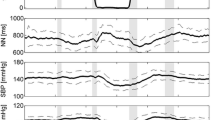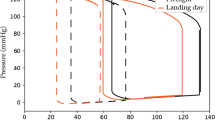Abstract
Purpose
Since manned missions to the Moon and Mars are planned, we conducted active standing tests with lunar, Martian, terrestrial, and 1.8 loads of inertial resistance (+Gz) modeled through defined parabolic flight maneuvers. We hypothesized that the cardiovascular response to active standing is proportional to the +Gz load.
Methods
During partial-+Gz parabolic flights, 14 healthy test subjects performed active stand-up maneuvers under 1 +Gz, lunar (0.16 +Gz), Martian (0.38 +Gz), and hyper inertial resistance (1.8 +Gz) while heart rate and finger blood pressure were continuously monitored. We quantified amplitudes and timing of orthostatic response immediately following standing up.
Results
The maximum early heart rate increase was 21 (SD ± 10) bpm with lunar, 23 (± 11) bpm with Martian, 34 (± 17) bpm with terrestrial +Gz, and 40 (± 11) bpm hyper +Gz. The time to maximum heart rate increased gradually with increasing loads of inertial resistance. The transient blood pressure reduction was most pronounced with hyper +Gz but did not differ significantly between lunar and Martian +Gz. The mean arterial pressure nadir was reached significantly later with Martian and lunar compared to 1 +Gz. Paradoxically, the time for blood pressure to recover was shortest with terrestrial +Gz.
Conclusion
While load of inertial resistance directly affects the magnitude of the transient blood pressure reduction and heart rate response to active standing, blood pressure stabilization is most rapidly attained during terrestrial +Gz. The observation might suggest that the human cardiovascular system is tuned to cope with orthostatic stress on earth.




Similar content being viewed by others
References
Buckey JC (2006) Space physiology. Oxford University Press, Oxford
Carter JR, Ray CA (2008) Sympathetic responses to vestibular activation in humans. Am J Physiol Regul Integr Comp Physiol 294:R681–R688
Gell CF, Jones WL (1971) Principles of biodynamics applicable to manned aerospace flight prolonged linear and radial acceleration with an annotated bibliography. Advisory group for aerospace research and development, Paris
Golding JF, Paillard AC, Normand H, Besnard S, Denise P (2017) Prevalence, predictors, and prevention of motion sickness in zero-G parabolic flights. Aerosp Med Hum Perform 88:3–9
Leguy CAD, Beck P, Gauger P, Beck LEJ, Limper U (2014) Carotid arterial wall dynamics during gravity changes on partial-G parabolic flights. Microgravity Sci Technol 26:111–117
Levine BD, Pawelczyk JA, Ertl AC, Cox JF, Zuckerman JH, Diedrich A, Biaggioni I, Ray CA, Smith ML, Iwase S, Saito M, Sugiyama Y, Mano T, Zhang R, Iwasaki K, Lane LD, Buckey JC Jr, Cooke WH, Baisch FJ, Eckberg DL, Blomqvist CG (2002) Human muscle sympathetic neural and haemodynamic responses to tilt following spaceflight. J Physiol 538:331–340
Limper U, Gauger P, Beck P, Krainski F, May F, Beck LE (2014) Interactions of the human cardiopulmonary, hormonal and body fluid systems in parabolic flight. Eur J Appl Physiol 114:1281–1295
Mayer B (2001) Phamakodynamik von Scopolamin und Ephedrin auf der Erde und in Schwerelosigkeit (Pharmacodynamics of scopolamine and ephedrine on earth and in weightlessness). Rheinisch-Westfälische Technische Hochschule Aachen, Aachen
Normand H, Lemarchand E, Arbeille P, Quarck G, Vaida P, Duretete A, Denise P (2007) Beat-to-beat agreement of noninvasive tonometric and intra-radial arterial blood pressure during microgravity and hypergravity generated by parabolic flights. Blood Press Monit 12:357–362
Pletser V, Winter J, Duclos F, Bret-Dibat T, Friedrich U, Clervoy J-F, Gharib T, Gai F, Minster O, Sundblad P (2012) The First joint European Partial-g Parabolic Flight Campaign at Moon and Mars gravity levels for science and exploration. Microgravity Sci Technol 24:383–395
Schlabs T, Rosales-Velderrain A, Ruckstuhl H, Stahn AC, Hargens AR (2013) Comparison of cardiovascular and biomechanical parameters of supine lower body negative pressure and upright lower body positive pressure to simulate activity in 1/6 G and 3/8 G. J Appl Physiol (1985) 115:275–284
Sjostrand T (1952) The regulation of the blood distribution in man. Acta Physiol Scand 26:312–327
Stenger M, Platts S, Lee S, Westby C, Phillips T, Arzeno N, Johnston S, Mulugeta L (2015) Evidence report: risk of orthostatic intolerance during re-exposure to gravity. National Aeronautics and Space Administration, Houston
Tschakovsky ME, Matusiak K, Vipond C, McVicar L (2011) Lower limb-localized vascular phenomena explain initial orthostatic hypotension upon standing from squat. Am J Physiol Heart Circ Physiol 301:H2102–H2112
van Wijnen VK, Finucane C, Harms MPM, Nolan H, Freeman RL, Westerhof BE, Kenny RA, Ter Maaten JC, Wieling W (2017) Noninvasive beat-to-beat finger arterial pressure monitoring during orthostasis: a comprehensive review of normal and abnormal responses at different ages. J Intern Med 282:468–483
van Wijnen VK, Harms MP, Go-Schon IK, Westerhof BE, Krediet CT, Stewart J, Wieling W (2016) Initial orthostatic hypotension in teenagers and young adults. Clin Auton Res 26:441–449
White RJ, Averner M (2001) Humans in space. Nature 409:1115–1118
Wieling W, Krediet CT, van Dijk N, Linzer M, Tschakovsky ME (2007) Initial orthostatic hypotension: review of a forgotten condition. Clin Sci (Lond) 112:157–165
Yates BJ, Stocker SD (1998) Integration of somatic and visceral inputs by the brainstem: functional considerations. Exp Brain Res 119:269–275
Acknowledgements
We thank the study participants for their dedication, Wolfram Sies and Stefan Moestl for constructing the parabolic flight rack and for technical support, and the NOVESPACE staff for the outstanding support during flight experiments. Moreover, we thank the German Aerospace Center (DLR) for providing the flight opportunities during the 1st and 2nd Joint European Partial-g Parabolic Flights. This work was performed with the support of the grants 50WB1155 and 50WB1255 of the German Federal Ministry of Economic Affairs and Energy and with a “Young Fellows” grant of the German Society of Aerospace Medicine (DGLRM).
Author information
Authors and Affiliations
Corresponding author
Ethics declarations
Conflict of interest
The authors declare that they have no conflict of interest related to this work.
Rights and permissions
About this article
Cite this article
Beck, P., Tank, J., Gauger, P. et al. Modeling human orthostatic responses on the Moon and on Mars. Clin Auton Res 28, 325–332 (2018). https://doi.org/10.1007/s10286-018-0527-x
Received:
Accepted:
Published:
Issue Date:
DOI: https://doi.org/10.1007/s10286-018-0527-x




